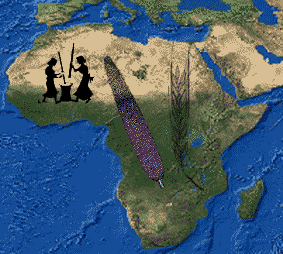|

|
 |

The Fifth International Workshop for African Archaeobotany will
be held 2-5 July, 2006
at the Institute of Archaeology,
University College London. For scheduled papers and absracts select days below.
|
The Fifth International Workshop for African Archaeobotany will
be held 2-5 July, 2006 |
|
|
Wednesday, 5 July, 2006 Session: Archaeobotany and political economy--
Plant macro remains from a Middle Kingdom Site at North Saqqara, Egypt.
*Ahmed Gamal-El-Din Fahmy, **Sakuji Yoshimura & **Nozomu Kawai *Department of Botany & Microbiology , Faculty of Science, University of Helwan, Cairo, Egypt
This paper presents archaeobotanical results of the finds from two rock-cut chambers dating to the Egyptian Middle Kingdom (BC. ca. 1900-1785) at Northwest Saqqara, excavated by Waseda University Expedition. The rock-cut chambers are situated in the middle of the slope to the south-east from the monument of Khaemwaset on the top of the highest outcrop in the Abusir-Saqqara necropolis. The rock-cut chambers are named AKT01 and AKT02, respectively. The rock-cut chamber AKT01 has T-shaped, consisting of the transverse hall and inner chamber. The rock-cut chamber AKT02 is comprised of a shaft, west chamber, east chamber, and east chamber’s forecourt. Clearance in both chambers indicates that this context had never been used for a burial; rather a number of statue fragments of terra cotta and wood were recovered as well as pottery. Preliminary archaeological/Egyptological interpretation suggests that the chambers could possibly have been used for the place of the ritual burial of divine statuary in the Middle Kingdom Egypt. Well-preserved plant remains were found in pits, vessels as well as upon the floor. Although these plant remains were deposited as offerings for the statuary in this context, the contents shows the agricultural economy in the Middle Kingdom. Analysis of plant macro remains reveals that the agricultural economy of the site was based on cultivation of cereals such as emmer wheat (Triticum dicoccon Schrank ) and barley (Hordeum vulgare L.). Seeds of the leguminous plant white lupine (Lupinus albus L.) were recovered. Remains of the field weed assemblage include small numbers of four taxa: Lathyrus hirsutus, Phalaris minor, Vicia sp. Lathyrus hirsutus. Fruits of Christ´s thorn (Ziziphus spina-christi) dominate those of date-palm (Phoenix dactylifera) and Persea (Mimusops laurifolia (Forssk.) Friis. The current study shows that economy of Saqqara during Middle Kingdom period was based on cultivation of emmer wheat and barley as well as the gathering of wild fruits and tubers like Ziziphus spina-christi and Cyperus esculentus. The inhabitants of Upper Egypt had adopted a similar subsistence strategy during the Predynastic period, some 1800 years earlier. ... return to 5 July schedule |
|
Send mail to d.fuller@ucl.ac.uk with questions or
comments about this web site.
|